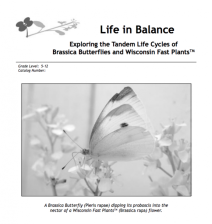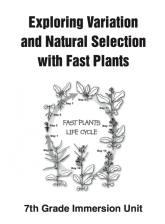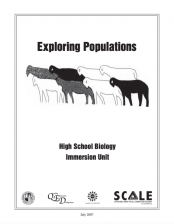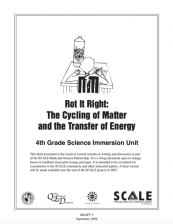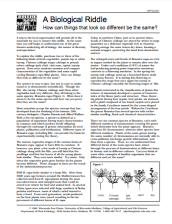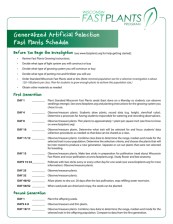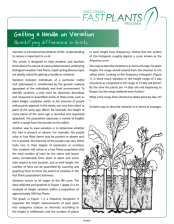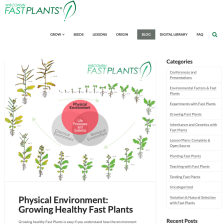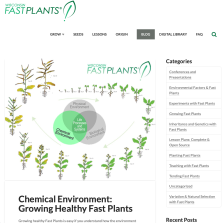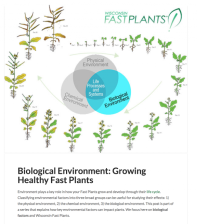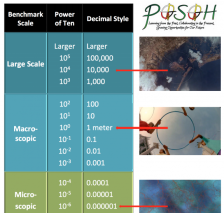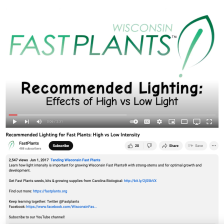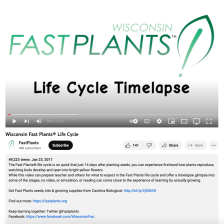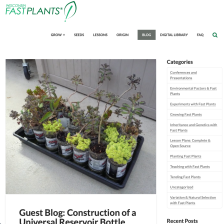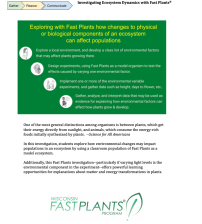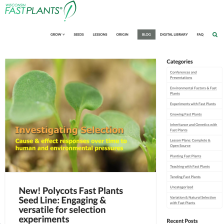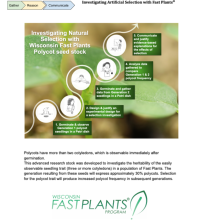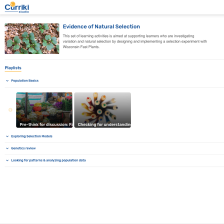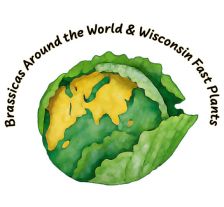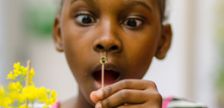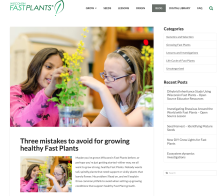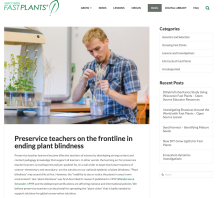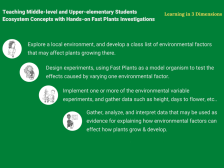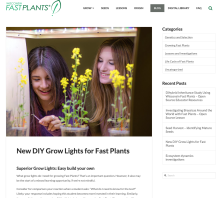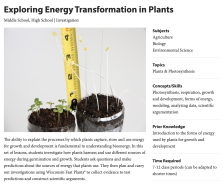Search Results
Searched for: Subject is Science -- Ecology, environment
Resources 1 - 25 of 25
Download this complete unit of instructions to conduct an ecosystem inquiry. In this investigation, students have the opportunity to witness first-hand the dynamic relationship between Brassica butterflies and Wisconsin Fast Plants. Students are responsible for tending the butterflies and plants...
Download this complete and coherently designed, middle school level unit to teach fundamental concepts that underpin the theory of evolution. The unit was collaboratively designed by teachers, college faculty & staff, and the Fast Plants Program at UW-Madison to support student-centered...
This Immersion Unit provides a coherent series of lessons designed to guide students in developing deep conceptual understanding that is aligned with the standards, key science concepts, and essential features of classroom inquiry (as defined by the National Science Education Standards).
Unit...
This Immersion Unit provides a coherent series of lessons designed to guide students in developing deep conceptual understanding that is aligned with the National standards, key science concepts, and essential features of classroom inquiry (as defined by the National Science Education Standards)....
Turnips, Chinese cabbage and Wisconsin Fast Plants (Rbr) look very different. Yet, they actually belong to the same species. This means that they have the same number of chromosomes and they can cross breed and produce fertile offspring. But how can you prove that plants that look so different are...
This fill-in-the-blank timeline is a planning tool for teachers to use when figuring out when to begin the steps associated with conducting a two-generation artificial selection experiment using Fast Plants. Teachers preparing for any selection experiment will find this timeline helpful, including...
This article is designed to help students and teachers think about the nature of various determinants underlying biological variation. Teachers facilitating any selection investigation will find this background information helpful, including those planning for the AP Biology Lab 1 of Big Idea 1:...
Read this blog post for background information about the relationship between the physical environment and life processes and systems in Fast Plants.
Growing healthy Fast Plants is easy if you understand how the environment can affect growth and development. Three broad categories of environmental...
Read this blog post for background information about the relationship between the chemical environment and life processes and systems in Fast Plants. Growing healthy Fast Plants is easy if you understand how the environment can affect growth and development. Three broad categories of environmental...
Read this blog post for background information about the relationship between the biological environment and life processes and systems in Fast Plants.
Growing healthy Fast Plants is easy if you understand how the environment can affect growth and development. Three broad categories of...
This is a printable poster resource developed by a collaboration of educators in the POSOH Project for teaching about systems and scale. This poster correlates with an excerpt from the video Cosmic Voyage about systems and scale, narrated by Morgan Freeman. A debrief discussion of that video excerpt...
This video is provided by Wisconsin Fast Plants, and introduces light intensity and its impact on plant growth. The video gives an overview of the effects of high light and low light intensities, and also includes a 20-day time lapse so the viewer can observe the effects that high and low light...
This video is provided by Wisconsin Fast Plants, and introduces the plant life cycle. The video features a 40-day time lapse of the Fast Plants from seeds during germination, through flowering and reproduction, until harvesting seeds at the end of the cycle. This recording runs for 02:19 minutes in...
This blog post, written by Joel Cryer of Bottle Biology, provides instructions to construct an inexpensive, self-watering planter that can be used to grow Wisconsin Fast Plants. The blog covers the materials and tools needed, as well as step-by-step instructions to create a universal reservoir...
This 16-page resource, from Wisconsin Fast Plants, provides a "complete Open Source investigation into ecosystem dynamics that can be adapted to any grade level." In this Google Document, readers will find the investigation includes a lesson plan, descriptions of standards alignment, tips for...
This blog post from the University of Wisconsin-Madison's Wisconsin Fast Plants, describes an investigation that educators can implement in the classroom to facilitate students' learning about variation and natural selection through firsthand observations and hands-on data collection in a very short...
This lesson plan, from the University of Wisconsin-Madisons Wisconsin Fast Plants, is for a high school biology investigation into evolution and artificial selection while using Fast Plants polycot seeds. The lesson plan describes student science performance for in-classroom learning as well as...
This resource, provided by Wisconsin Fast Plants and CurrikiStudio, contains a set of six different learning activities that can be implemented in classrooms to teach natural selection. Organized in playlists, these interactive lessons guide students through understanding and applying knowledge of...
This investigation begins with a phenomenon that is evidenced in most every produce aisle: Many of the vegetables that botanists classify as Brassica look and taste different. This investigation aligns with middle and high school Next Generation Science Standards as well as with agricultural science...
This blog post from the Fast Plants team addresses the question "can bee sticks sting?" (no, bee sticks cannot sting) and provides information on the use of bee sticks for pollination of Fast Plants in the classroom.
This blog post from the Wisconsin Fast Plants Team describes three ways to optimize your growing environment to grow healthy Fast Plants.
Tips for growing healthy plants are focused around the following three concepts, with descriptions of ideal environmental conditions for each:
1. Not enough...
This blog post on the Fast Plants website discusses the concept of plant blindness (the inability to see or notice the plants in one's own environment) and the importance of ending plant blindness and supporting plant vision. Fast Plants are an effective introduction to growing and noticing plants:...
This blog post from the Wisconsin Fast Plants website features an NGSS-aligned Open Source Lesson Plan for Investigating Ecosystem Dynamics with Fast Plants. The featured lesson plan is available to be downloaded and edited as needed via Google Drive. The investigation challenges students to gather...
This blog post by the Fast Plants Team provides a materials list and instructions for a Do-It-Yourself, LED Grow Light that is ideal for Fast Plants growth. This grow light uses cost-effective materials that can be obtained online and from a local hardware store. The light is easy to construct,...
In this set of lessons and Fast Plants experiment, students investigate how plants harness and use different sources of energy during germination and growth. Students ask questions and make predictions about the sources of energy that plants use. They then plan and carry out investigations using...
Publisherv
Creatorv
Languagev
Phenotypic Traitv
Genotypev
Speciesv
Materials Development Erav
Media Formatv
Audiencev
Subjectʌ
- ☐ Arts
- ☐ Educational Technology
- ☐ Foreign Languages
- ☐ Language Arts
- ☐ Mathematics
- ☐ Science
- ☐ Social studies
Resource Typev
Classificationv
Education Levelv
